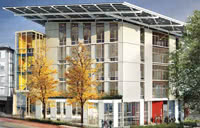Construction Management
How BEMS and Seattle's Bullitt Center are Pioneering Green Construction

This past Earth Day, Seattle’s Bullitt Center broke ground in the construction industry by becoming the first zero energy building of its kind. Unlike previous attempts at incentivized green architecture like the LEED program which has been criticized for its mixed results, the Bullitt Center uses a combination of developmental monitoring software and hardware paired with energy-conscious materials and design to keep it at an optimal balance of comfortability and energy efficiency. Its primary goal is to meet the requirements of the Living Building Challenge, a hyper-intensive certification process that, “requires both water and energy self-sufficiency, among a list of 20 demands.” While meeting the criteria of such a grueling program will certainly prove a challenge for the Bullitt Center, its chances are significantly better than they would have been only a few years ago due to the improvement and proliferation of BEMS (building energy management systems) which allow for remote auditing of a structure’s energy efficiency for the purpose of eliminating easily fixable problems to achieve overall energy neutrality or even surplus.
Living Building Challenge
So far only three buildings in the United States have stood up to the 12 month Living Building Challenge test which goes beyond construction in demanding a commitment to austerity from its tenants that includes, “strict annual usage budgets [and payment for] overages.” Companies housed in the building won’t be left to their own devices; however, as built-in technology like, “extra-fine electrical circuits and detailed outlet metering can help diagnose problem spots down to, say, a malfunctioning printer.” Likewise, chief architect Casey Schuchart used advanced 3-D modeling software to generate early models of the building and ensure compliance with Living Building standards:
As the building design migrated from the screen to the manufacturing process and then to the installation, the properly coordinated design model enhanced productivity on site. The utilization of digital representations of our designs allowed for close coordination, all towards the final delivery of those systems in the building.
Building Energy Management Systems
Like many innovative projects of today, none of the Bullitt Center’s ambitious goals would have been feasible without the ability to collect data on as many measurable aspects of the building’s operation as possible. Thanks to companies like Retroficiency who develop BEMS software that enables remote energy auditing, data such as, “square footage, use types, hours of occupation, and types of lighting,” can be, “combined with other data in an algorithm to infer thousands of data points of energy consumption in a building.” In the past, this kind of detailed auditing could only be performed during an on-site visit and would be subject to human error and oversight. As Retroficiency CEO Bennett Fisher told Green Tech Advocates in a recent article,
The overarching problem in the industry is that the manual process is very unscalable. It would take every auditor working around the clock for 22 years to assess which buildings have the right opportunities. Our whole mission is to bring scale to energy efficiency.
While BEMS systems may never make in-person auditing obsolete, according to a 2012 report by Pike Research we are currently on the cusp of widespread BEMS adoption. Pike’s research projected that, “global revenues from building energy management systems (BEMS) are expected to rise almost 14 percent per year through the end of the decade, realizing a market of slightly less than $6 billion by 2020.” Though the cost of implementation is relatively high today, the investment in BEMS is one that pays for itself quickly by identifying inefficiencies that would have persisted between isolated on-premise audits or been missed altogether. This theory is bolstered by an IDC Energy Insights survey of American building owners released earlier this month which shows that, “50 percent of the respondents reported that they use Smart Building technologies today, with another 33 percent stating they would use smart building technologies in the next six months or year.”
The Smart Building
By pairing analytics technology developed in the software world with new developments in hardware, the line between animate and inanimate is becoming ever harder to distinguish. As Denis Hayes, president and CEO of the Bullitt Foundation, describes the building, “It has eyes, it has ears, it has a nervous system, it has a brain and it responds to its environment in a way that seeks to optimize things.” This isn’t to say that we should all be dreading our impending Smart House(s), but that the built environment is beginning to take on a life of its own, that architecture might coexist with the earth through symbiosis of organic and manufactured components. These are undoubtedly lofty goals, but the Bullitt Center is just the beginning, it is an example for others to replicate. NPR’s Wendy Kaufman put it best when she said:
If you think of it as simply an office building, it was relatively expensive to design and build. But if you view it as a laboratory, an educational center and a bold effort to change how things are built, the calculus changes.
Want to read more insider-perspective posts? Browse our entire archive of blog posts on news from the software industry by visiting the Industry News and Events section of the Business-Software.com blog.





